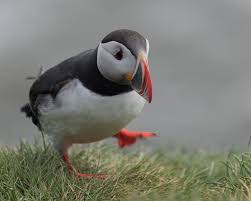
I have never forgotten the moment I saw my first puffin. I was sitting by the sea at Auchmithie, a small fishing hamlet on the east coast of Scotland, birthplace of that culinary delight the Arbroath Smokie! The day was sunny, but a stiff breeze forced the waves into a disorderly queue, before sending white-topped breakers to rattle the pebbles of Auchmithie Bay.
The bird flew along the shoreline in front of me, wings flapping vigorously. There was nothing unusual about the black and white plumage and it would not have caught my attention except for a flash of what seemed like the painted face of a circus clown with a protuberant false orange nose – the kind you might hold in place with an elastic band around the back of your head. It was unmistakably a puffin and it would be thirty years until I saw another one.
Puffins belong to the Auk family and there are three species found in the North Pacific Ocean but only one in the North Atlantic. Slightly larger than a pigeon, the Atlantic Puffin is the smallest and most common of them all. Sometimes referred to as Clown of the Sea or Sea Parrot, on account of its unusual beak and head markings, it has been characterized in animations, comic strips, book illustrations and on postage stamps.
Widely distributed, it can be found from eastern America to northern Russia and from northern France to Iceland but falling numbers in recent years are causing concern.
Research indicates that around 10 per cent of Atlantic Puffins breed in the British Isles, with Scotland playing host to large colonies on some of its rugged coastlines and islands.
The birds, which are monogamous, arrive at their breeding grounds towards the end of March and pairs soon begin reinforcing their bond with much rubbing of their bright orange beaks. Within weeks, the colony becomes a hive of activity with thousands of puffins flying, fishing, swimming and congregating in giant rafts on the nearby sea and then preparing burrows in the soft soil at the tops of cliffs in preparation for the single egg they will lay. Amidst all this activity can be heard the little growls and squawks that are their unique way of communicating.
 Parents share all responsibilities, including burrow digging, egg incubation, fishing and feeding the chick that will hatch around June or July. The main sources of food are sand eels and sprats and catching these can necessitate swimming to depths in excess of 50 meters!
Parents share all responsibilities, including burrow digging, egg incubation, fishing and feeding the chick that will hatch around June or July. The main sources of food are sand eels and sprats and catching these can necessitate swimming to depths in excess of 50 meters!
Once hatched, the pufflings – as they are known – fledge by making their way alone, usually under cover of darkness, to the cliff tops and then to the sea below.
It would be reasonable to assume that by living in remote locations puffins are protected from many of the dangers affecting other birds. Sadly, this is not the case and they are especially vulnerable to environmental disasters such as oil spills.
The sinking of the Torrey Canyon supertanker and the resultant oil spill off the coast of Cornwall in 1967 caused the deaths of thousands of puffins, including 80 per cent of those along the French coast of Brittany. Similarly, with large numbers of puffins concentrated at localized breeding sites and only a single egg being produced each year, the introduction of a predator, such as a mink or rat, can be devastating.
At other times, something seemingly innocuous can have immense consequences. Paul Nixon of the Scottish Seabird Centre in North Berwick says that officers monitoring the island of Craigleith in the Firth of Forth recently became aware of an enormous dip in puffin numbers – they had fallen from around 28,000 pairs to just a few thousand. A giant plant called a tree mallow was the cause of the problem.
“It had been introduced to the islands by lighthouse keepers 300 years ago for medicinal purposes but had spread out of control and was preventing the puffins from nesting and rearing their pufflings,” Nixon explains.
It took 140 work parties of 700 volunteers to cut down the tree mallow!
Changing weather patterns also have an impact and over the last few years summers inScotlandhave become wetter. This year has seen record-breaking rainfall with reports of puffin burrows being inundated with water.
Although Atlantic Puffin numbers have fallen significantly over the last decade some colonies are doing well. However, no one is complacent and Dr Andy Douse, an ornithologist with Scottish Natural Heritage, confirms that the Centre for Ecology and Hydrology is continuing with important monitoring work, especially on the Isle of May.
And while there is reason for cautious optimism, concern is such that at present the Atlantic Puffin is on the Amber list of UK Birds of Conservation Concern. It would be nice to think that in 30 years’ time these wonderful birds may still be found at Auchmithie and many other places too.
Story by Tom Langlands




















Leave a Comment